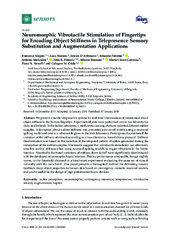Приказ основних података о документу
Neuromorphic Vibrotactile Stimulation of Fingertips for Encoding Object Stiffness in Telepresence Sensory Substitution and Augmentation Applications
| dc.creator | Sorgini, Francesca | |
| dc.creator | Massari, Luca | |
| dc.creator | D'Abbraccio, Jessica | |
| dc.creator | Palermo, Eduardo | |
| dc.creator | Menciassi, Arianna | |
| dc.creator | Petrović, Petar | |
| dc.creator | Mazzoni, Alberto | |
| dc.creator | Carrozza, Maria Chiara | |
| dc.creator | Newell, Fiona N. | |
| dc.creator | Oddo, Calogero Maria | |
| dc.date.accessioned | 2022-09-19T18:22:55Z | |
| dc.date.available | 2022-09-19T18:22:55Z | |
| dc.date.issued | 2018 | |
| dc.identifier.issn | 1424-8220 | |
| dc.identifier.uri | https://machinery.mas.bg.ac.rs/handle/123456789/2755 | |
| dc.description.abstract | We present a tactile telepresence system for real-time transmission of information about object stiffness to the human fingertips. Experimental tests were performed across two laboratories (Italy and Ireland). In the Italian laboratory, a mechatronic sensing platform indented different rubber samples. Information about rubber stiffness was converted into on-off events using a neuronal spiking model and sent to a vibrotactile glove in the Irish laboratory. Participants discriminated the variation of the stiffness of stimuli according to a two-alternative forced choice protocol. Stiffness discrimination was based on the variation of the temporal pattern of spikes generated during the indentation of the rubber samples. The results suggest that vibrotactile stimulation can effectively simulate surface stiffness when using neuronal spiking models to trigger vibrations in the haptic interface. Specifically, fractional variations of stiffness down to 0.67 were significantly discriminated with the developed neuromorphic haptic interface. This is a performance comparable, though slightly worse, to the threshold obtained in a benchmark experiment evaluating the same set of stimuli naturally with the own hand. Our paper presents a bioinspired method for delivering sensory feedback about object properties to human skin based on contingency-mimetic neuronal models, and can be useful for the design of high performance haptic devices. | en |
| dc.publisher | MDPI, Basel | |
| dc.relation | Italian Ministry of Education, Universities and Research within the "Smart Cities and Social Innovation Under 30" program through the PARLOMA Project [SIN_00132] | |
| dc.relation | Tuscany Region [D66D16000120002 | |
| dc.relation | National Institute for Insurance against Accidents at Work (INAIL) via the MOTU project | |
| dc.relation | Italian Ministry of Foreign Affairs and International Cooperation via the Italy-Serbia bilateral project Human-Robot Co-Working as a Key Enabling Technology for the Factories of Future [PGR00758/2017] | |
| dc.rights | openAccess | |
| dc.rights.uri | https://creativecommons.org/licenses/by/4.0/ | |
| dc.source | Sensors | |
| dc.subject | vibrotactile | en |
| dc.subject | telepresence | en |
| dc.subject | tactile perception | en |
| dc.subject | sensory augmentation | en |
| dc.subject | neuromorphic | en |
| dc.subject | haptics | en |
| dc.subject | contingency-mimetics | en |
| dc.title | Neuromorphic Vibrotactile Stimulation of Fingertips for Encoding Object Stiffness in Telepresence Sensory Substitution and Augmentation Applications | en |
| dc.type | article | |
| dc.rights.license | BY | |
| dc.citation.issue | 1 | |
| dc.citation.other | 18(1): - | |
| dc.citation.rank | M21 | |
| dc.citation.volume | 18 | |
| dc.identifier.doi | 10.3390/s18010261 | |
| dc.identifier.fulltext | http://machinery.mas.bg.ac.rs/bitstream/id/1454/2752.pdf | |
| dc.identifier.pmid | 29342076 | |
| dc.identifier.scopus | 2-s2.0-85040905144 | |
| dc.identifier.wos | 000423286300260 | |
| dc.type.version | publishedVersion |


